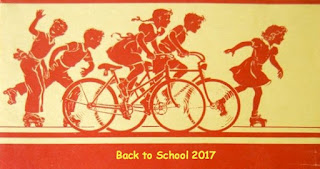When my Kiddo was in middle school, she kept forgetting assignments because she didn’t write them down. When I found out, I didn’t waste any time in getting her a daily planner to keep track of things. What a difference it made in her success as a student. Keeping track of her life with a planner has been part of her life ever since. Too bad she didn’t have this fun planner from National Geographic Kids.
Weird but true! is more than just a planner. A year long academic calendar, it runs from August 1st to July 31st. The first page of every month has room for writing goals that your kids may need or want to accomplish that month needs to be remembered to do. And each day of the month has enough room for writing down assignments, keeping track of after school activities, and even appointments, as well as some fun, interesting facts about that particular month.
This Weird but True! is a customizable planner because it is not year specific, it only becomes so when a student starts using it. All they have to do is find the day they are going to start using the planner, then just circle the day of the week for their first entry, and it become year specific.
There lots of extras, too. Like right up front is a two page spread where students can fill in their school schedule, including time, room, subject and teacher. At the back, students will find homework help, including a world map and information on finding their way around, plus a guide to writing a good report, and advice for giving a good oral report, and there are charts - with distances, the metric system, and that favorite, the multiplication chart. Mixed in throughout the books are fun facts and even a few pop quizzes.
When I was in fourth grade, my most prized possession was a large, spiral bound book that included information and maps of New York City's five boroughs. That was the year we learned the history of New York at the same time we were taught how to use maps. It was a lesson I learned so well, that I still have a real appreciation for the value of maps. And now, National Geographic Kids has released a new edition of their United States Atlas. As they say on the cover: "It's your country. Learn it. Love it. Explore it."
The country is divided into five regions - the Northeast, the Southeast, the Midwest, the Southwest and the West, and includes United States territories. Each region includes a physical and political map (no, the political map is a map of who voted for whom, but a map that shows state or country boundaries, large bodies of water, and the where major cities are located).
After exploring a region, there are detailed maps and information about each state within that region. Information on each states economy, natural resources, unique attractions as well as the basics - the population, the capital, state bird and flower, and interesting facts about different cities within the state. At the back of the book, students can find detailed information about U.S. territories of Guam, American Samoa, the U.S. Virgin Islands, Puerto Rico and the Northern Mariana Islands. Included are also U.S. Facts & Figures, a Glossary and Postal Abbreviations, Map Abbreviations and websites where more information can be found.
These are both essential tools for success in school and just as they always do, National Geographic has included incredible full-color photographs throughout both books. Both books are useful outside of school, as well. Families can plan their next vacation using the United States Atlas and kids can keep track of the interesting sights they visit in their planner. Either way, these are invaluable books that will be used again and again.
These book are recommended for readers age 9+
These books were sent to me by Media Masters Publiciaty
The country is divided into five regions - the Northeast, the Southeast, the Midwest, the Southwest and the West, and includes United States territories. Each region includes a physical and political map (no, the political map is a map of who voted for whom, but a map that shows state or country boundaries, large bodies of water, and the where major cities are located).
After exploring a region, there are detailed maps and information about each state within that region. Information on each states economy, natural resources, unique attractions as well as the basics - the population, the capital, state bird and flower, and interesting facts about different cities within the state. At the back of the book, students can find detailed information about U.S. territories of Guam, American Samoa, the U.S. Virgin Islands, Puerto Rico and the Northern Mariana Islands. Included are also U.S. Facts & Figures, a Glossary and Postal Abbreviations, Map Abbreviations and websites where more information can be found.
These are both essential tools for success in school and just as they always do, National Geographic has included incredible full-color photographs throughout both books. Both books are useful outside of school, as well. Families can plan their next vacation using the United States Atlas and kids can keep track of the interesting sights they visit in their planner. Either way, these are invaluable books that will be used again and again.
These book are recommended for readers age 9+
These books were sent to me by Media Masters Publiciaty







































No comments:
Post a Comment